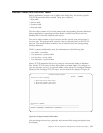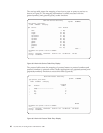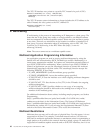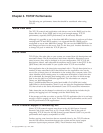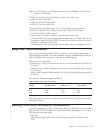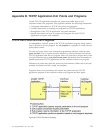
Note: If you configure your 100 Mbps ethernet line for TCPONLY, all IOP assist
functions are disabled.
TCP/IP-assist functions that are available on frame relay IOAs are:
v #2699 Two-Line WAN IOA
v #2720 PCI WAN/Twinaxial IOA
v #2721 PCI Two-Line WAN IOA
Communications restrictions apply if any of the following communication
functions are required when using the frame relay IOAs, as listed above:
v X.25, Frame Relay, or IPX Protocol
v SDLC protocol, if used to connect to more than 64 remote sites
v Communications line speeds greater than 64 Kbps and up to 2.048 Mbps for the
synchronous data link control (SDLC) or frame relay protocols (bisync is always
limited to a maximum of 64 Kbps)
v Communications line speeds greater than 64 Kbps and up to 640Kbps for X.25
Merge Host Table Performance
You can use the following data to help you plan for and anticipate performance
when merging host tables. The data represents averages of measurements that are
taken. The actual time required on your server will be different.
Three cases were measured:
v Small merge—merge a 250-record file into the local host table that currently has
50 entries
v Medium merge—merge a 2000-record file into the local host table that currently
has 50 entries
v Large merge—merge a 5000-record file into the local host table that currently has
50 entries.
The results of this test are shown in Table 7.
Table 7. Merge Host Table Performance
Number of records
merged Record format
Elapsed time
(min:sec) CPU percent
250 *AIX 0:42 43.7
2000 *NIC 5:38 49.4
5000 *NIC 13:54 48.6
This data equates to about 6 records per second and about .07-.08 processing unit
seconds per record.
Running TCP/IP Only: Performance Considerations
Certain configurations of 2838 - 10/100 Mbps Ethernet cards allow you to run the
IOP with only TCP/IP instead of all protocols for better performance. You need a
2838 Ethernet card with either:
v 2810 IOP
v 2809 IOP (the 2838 must be the only input/output adapter (IOA)IOA on the
IOP)
Chapter 3. TCP/IP Performance 73
|
|
|
|
|
|
|
|
|
|
|
|



